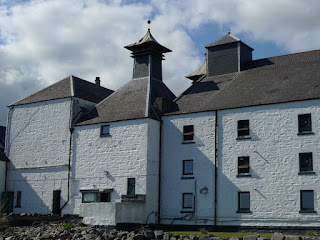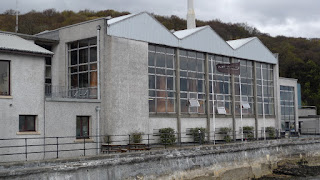Today was the big day, with extensive tasting tours at
Lagavulin and Ardbeg. Fortunately they are both within 3 miles of where I am
staying.
We started at Lagavulin with the standard distillery tour in
the morning. Usually these tours are given by someone who is fairly young and
has only worked as a tour guide / retail shop employee. The guides are
generally well informed, but you just can’t get the insight and depth that
comes from an old timer who has worked every job at the distillery through their
life. Our tour guide this morning was Marjorie, and she was somewhere between
those two extremes. Being a bit older and married to a former Lagavulin
distillery engineer (as well as her father having been a malt-man at Ardbeg
many years ago), made her a very competent tour guide.

As I explained yesterday, we were told that the size of the
cut (of spirit coming off the still) is something that differentiates Caol Ila
and Lagavulin. Today we were told that Lagavulin has a slower distillation,
which helps it retain its full peat intensity. They likened it to slow cooking food
at a low temperature to retain flavor, where Caol Ila has a hotter, faster
distillation, sort of cooking off some of its smoky character. I assume they
are both correct, and the combination of those two differences in process is
what gives the two whiskies their individual styles.
As expected we were banned from photography during the tour,
although I did manage to get a shot of the stills through an open door while
wandering around outside later in the day.
But the real treat came after the standard tour, when we
took the warehouse demo tour with Iain McArthur. This is the real deal, an
employee here for 42 years who started off painting the ends of the casks at
the age of 15, and he has done nearly every job at Lagavulin. He is a walking,
talking history book. No question is too tough, and every answer is honest, not
to mention his great sense of humor and wonderful character. Iain leads this
tasting demonstration which starts with new make spirit, and goes through
samples drawn directly from four casks, progressing in through a range of ages
and barrel types.
New Make Spirit, 68-69% abv. Big, hot, interesting mix of
floral and smoke. Tastes like Death’s Door with peat smoke added.
12yr, 55% abv, 2nd fill bourbon barrel. Mild up
front, with sweet/fruit flavors, then building, evolving peat smoke flavors,
burning embers and campfire.
15yr, 52.4% abv, 4th fill bourbon barrel. Mild
nose, pale color, mild up front, bigger blast of peat, mixed with mild floral
notes, flavor comes in waves.
19yr, 53% abv, ex-sherry butt. Smooth, complex, dark fruits,
long finish, wonderful balance, sublime.
46yr, abv not specified but claimed to be over 40%, bourbon
barrel, fill # unknown. Wonderful mild palate, smooth and easy to drink, very
little smoke left at this age, turns too woody on the finish. According to
Iain, if they were to bottle this whisky, it would retail between £2000 and
£3000 per bottle!
From there, we made are way down the road to Ardbeg, where
we had lunch at the Old Kiln Café, which is in their old malt building
(outstanding food by the way). Next up was the Old Ardbeg / New Ardbeg Tour.
Ardbeg was shut down in 1981 for what they thought would
just be a few weeks at the time. This turned into a long term closing, and the
distillery was almost lost forever, but it did come back with limited
production from 1989-1996. In 1997 Hiram Walker sold the distillery to
Glenmorangie, who restarted production and went to full production a year later.
With a long period of no distilling followed by years of minimal activity, they
had some huge gaps in the age of their stocks. Because of this, they have had
various bottlings run out, and new variations of Ardbeg have replaced them over
the recent years. This tour provides a tasting that explores the new varieties
versus the lost ones, a rare opportunity indeed.
The tour started off in a former malt building, with a taste
of the 17 year, which was an Ardbeg icon before it vanished. The company had
found a forgotten surplus of 17yr miniatures that they chose to use for this
tour’s tastings.
Ardbeg 17yr, 40%. Bright fruit, light smoke nose. Wonderful
back and forth from fruit to smoke through several cycles. Very long finish.
Peat flavors are intense but soft.
From here we ran through the typical distillery tour,
exploring the various parts of the operation. And finally, we were on a tour
where photography was allowed. Distillery photos abound!
At the end we were taken to a tasting room where the rest of
the sampling took place. We tried an interesting mix of cask samples, current
bottlings, and two more “no longer available” bottlings, one from another stash
of rediscovered minis.
10yr, cask sample, 54.7%, 2nd fill bourbon
barrel. Campfire smoke, tar, coal, intense long fiery finish.
Kildalton (generally not available, from minis), made from
very lightly peated malt, 24yr (distilled 1981, bottled 2005), 52.6%. Tropical
fruit nose, fruit on palate, feels like peat coming on, but quickly gives way
to nice mix of fruit (pineapple, mango, etc) and oak flavors which dance around
with cask strength intensity.
14yr, cask sample, 53.9%, 2nd fill sherry cask.
Big nose of dark fruit & smoke. Great intensity. Fruit up front followed by
a blast of fiery smoke, long smooth finish.
Airigh Nam Beist (a limited edition bottling, almost
impossible to find for the last two year, but the distillery still has a few
bottles), distilled 1990, bottled 2006, 46%. Mild nose, soft burning peat
builds slowly in intensity. Long, lovely finish.
Next we were given a choice of current bottlings – Corryvreckan
(aged in new toasted French oak) or Alligator (aged in a mix of bourbon barrels
and new American oak with a #4 char). I went with the latter, since I have a
bottle of the former at home.
Alligator (no age statement, claimed to be a mix of 10yr to
12yr) 51.2%. Mild nose, sweet vanilla and caramel flavors followed by strong
peat which builds in intensity through the long finish.
That was the end of the tasting, but a few guys that were
lingering around at the end convinced the guide to give us a small sample of
the Blasda, their current mildly peated offering. I didn’t take tasting notes
at the time (my palate was pretty much fried by that point anyway). However, I
do remember it being enjoyable but not nearly as special as the Kildalton.

This was a really good tour, with the chance to taste
whiskies that are now almost impossible to obtain. But I think it could have
been better if it had been structured a little differently. We worked through a
lot of samples fairly rapidly at the end, and the order in which we tasted them
didn’t make much sense. When I do big tastings, I find it best to start with
lower proof and less flavor intensity (peat levels in this case), and work your
way up. I think this tour would be improved by spreading out the tastings and
changing their order. Maybe start in the old malt room with Blasda followed by
Kildalton, then tour most of the distillery, and go up to the tasting room for
the 17yr, followed by Airigh Nam Beist (which is unavailable now, but was
introduced around the time supplies of the 17 tapered off), then follow that
with a choice of Alligator or Corryvreckan. At the end, down to the warehouse /
cask filling room for a short talk about the work that goes on there, followed
by the two cask samples.
After dinner, I somehow managed to wander over to the
local pub for one last drink. I tried the Bruichladdich First Growth Cuvee C: Margaux
(Chateau Margaux) 16yr. This was a very nice way to finish the day after
endlessly bombarding myself with peat monsters.















































